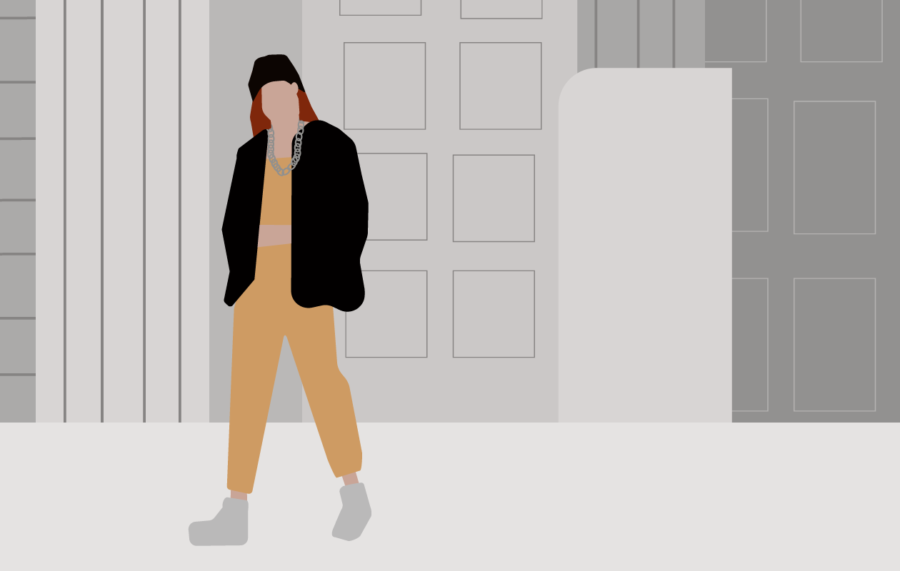A concrete jungle. Darting between the immovable brick trees and pavement rivers, the animals move in synced migration. Creatures of fashion. Savages of style. The primal nature of fashionistas living in modern, metropolitan areas was best represented by the 2006 fashion-based film, “The Devil Wears Prada.” This dramedy features an iconic photoshoot in Central Park entitled “Urban Jungle.” Obviously inspired by the New York City nickname, the Concrete Jungle, this photoshoot demonstrated the parallels between the city and nature. This take on fashion continues in metropolitan areas today in movements like streetwear. Living mannequins sporting the most influential fashion movement of the late 20th and early 21st centuries: street style.
While the street style campaign was expected to be a revolution, abrupt and short-lived, it shook the fashion industry in a way that more accurately resembled evolution. Despite bearing an association of near synonymy with modern skateboard and surf culture brands like Shawn Stussy, streetwear has roots in a more dated era. According to menswear designer Matt Nation in an interview with fashion news outlet and Target brand label Who What Wear, the street style movement began well before it was assigned an unambiguous identity.
“Streetwear is a byproduct of wider subcultural movements like hip-hop and skateboarding, so what we now call streetwear has been evolving since the 1970s,” Nation said.
In its early stages, street style was said to have been the perfect marriage of three different fashion categories: sportswear, punk and Japanese fashion. Let’s first cover the premiere influence, sportswear. Athletic attire has dominated the 21st century thus far. From Nike and Adidas sneakers to Fabletics leggings, athleticwear has become a mainstream staple in the fashion diet. In addition to its mainstream appeal, athletic clothing and accessories have also generated a lot of hype around more exclusive products, making it a significant contributor to the street style movement. The influence of Adidas sneakers on streetwear was explored in a blog post by Philadelphia lifestyle retail brand, Urban Outfitters.
First introduced as a volleyball sneaker in 1969, the Adidas Superstar has become one of the most influential and crossover styles in the history of fashion. The shoe skyrocketed into the public eye and became a staple of streetwear connoisseurs the world over.
Another subcategory influencer of the early streetwear market was the punk movement. From spikes, to leather and deep-black eyeliner, punk is a fashion statement that doesn’t obey societal expectations. The punk movement’s ability to rebel through fashion translated into one of the main influences for the street style movement. Vogue noted this in a 2017 article, stating that many modern streetwear designers “cite punk’s nihilistic ingenuity as a huge influence.”
Japanese fashion also had a significant influence on the street style movement. Fashion designers from Japan such as Rei Kawakubo have always inspired western designers including Alexander McQueen and John Galliano. But there is one Japanese movement that stands out as a game-changer for street style: Harajuku. Based out of the Harajuku district of Tokyo, Harajuku fashion is popular among the younger generation and rejects social norms through vibrant colors, exaggerated silhouettes and over-the-top fabrics. It is no surprise that a rebellious fashion movement such as Harajuku had such an impact on the streetwear movement that is founded on the idea of dismissing norms, much like the punk movement did. This eastern influence on western fashion movements bled into the creative foundations of streetwear. Fashion United analyzed Japanese fashion’s influence on street style. According to the fashion platform, London’s street fashion subcultures were inspired by Harajuku, taking on Japonisme, with street brands such as Maharishi continuing to use motifs such as dragons in their designs.
Despite these three sub-categories of the fashion industry taking center stage as influencers of street wear, the market for street style has evolved into a more high fashion entity. Street style now has more in common with Paris Haute Couture than the local, grungy skate park. While some may believe this evolution to be indicative of the lost vision of streetwear’s roots, others argue that this mainstream adoption of street style has allowed the movement to become more influential in the fashion industry. And the trend of street style on the rise doesn’t seem to be coming to a close anytime soon. In a report by major fashion forecasting company WGSN, it was projected that the market for streetwear will continue to grow rather than dwindle. In their February report, WGSN announced that despite reports suggesting the demise of streetwear, the category is expected to soar to $429 billion in sales by 2025.
This report proves that street style is truly an evolution rather than a sporadic revolution. The untamed creatures will continue roaming the pavement trails of the urban wilderness. The street style trendsetters will persist in their hunt for the latest fashion, the concrete jungle their natural habitat.












